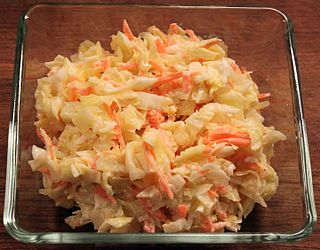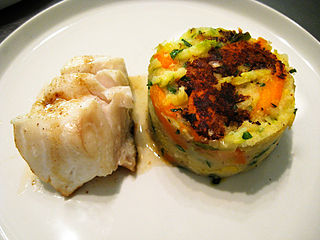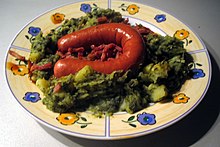
Rutabaga or swede is a root vegetable, a form of Brassica napus. Other names include Swedish turnip, neep (Scots), and turnip. However, elsewhere, the name "turnip" usually refers to the related white turnip. The species Brassica napus originated as a hybrid between the cabbage and the turnip. Rutabaga roots are eaten as human food in various ways, and the leaves can be eaten as a leaf vegetable. The roots and tops are also used for livestock, fed directly in the winter or foraged in the field during the other seasons. Scotland, Northern and Western England, Wales, the Isle of Man, and Ireland had a tradition of carving the roots into Jack-o'-lanterns at Halloween.

Goulash is a soup or stew of meat and vegetables seasoned with paprika and other spices. Originating in Hungary, goulash is a common meal predominantly eaten in Central Europe but also in other parts of Europe. It is one of the national dishes of Hungary and a symbol of the country.

Meatloaf is a dish of ground meat that has been combined with other ingredients and formed into the shape of a loaf, then baked or smoked. The final shape is either hand-formed on a baking tray, or pan-formed by cooking it in a loaf pan. It is usually made with ground beef, although ground lamb, pork, veal, venison, poultry, and seafood are also used, sometimes in combination. Vegetarian adaptations of meatloaf may use imitation meat or pulses.

Polish cuisine is a style of food preparation originating in and widely popular in Poland. Due to Poland's history, Polish cuisine has evolved over the centuries to be very eclectic, and shares many similarities with other national cuisines. Polish cooking in other cultures is often referred to as à la polonaise.

Coleslaw, also known as cole slaw, or simply as slaw, is a side dish consisting primarily of finely shredded raw cabbage with a salad dressing or condiment, commonly either vinaigrette or mayonnaise. This dish originated in the Netherlands in the 18th century. Coleslaw prepared with vinaigrette may benefit from the long lifespan granted by pickling.

Dutch cuisine is formed from the cooking traditions and practices of the Netherlands. The country's cuisine is shaped by its location in the fertile North Sea river delta of the European Plain, giving rise to fishing, farming and overseas trade. The Burgundian-Habsburg court enriched the cuisine of the Dutch elite in the 15th and 16th century, so did the colonial spice trade in the 17th century.

A ham hock or pork knuckle is the joint between the tibia/fibula and the metatarsals of the foot of a pig, where the foot was attached to the hog's leg. It is the portion of the leg that is neither part of the ham proper nor the ankle or foot (trotter), but rather the extreme shank end of the leg bone.

Pennsylvania Dutch cuisine is the typical and traditional fare of the Pennsylvania Dutch. According to one writer, "If you had to make a short list of regions in the United States where regional food is actually consumed on a daily basis, the land of the Pennsylvania Dutch—in and around Lancaster County, Pennsylvania—would be at or near the top of that list," mainly because the area is a cultural enclave of Pennsylvania Dutch culture.
Norwegian cuisine in its traditional form is based largely on the raw materials readily available in Norway and its mountains, wilderness, and coast. It differs in many respects from continental cuisine through the stronger focus on game and fish. Many of the traditional dishes are the result of using conserved materials, necessary because of the long winters.
Soup beans is a term common in the Southern United States, particularly the regions around the Appalachian Mountains. Soup beans are usually served with cornbread, greens, and potatoes and may be topped with raw chopped onions or ramps. Soup beans are considered a main course, but also serve as a side dish. In rural areas, where food was scarce during the winter, these dried beans were a staple food.

Czech cuisine has both influenced and been influenced by the cuisines of surrounding countries and nations. Many of the cakes and pastries that are popular in Central Europe originated within the Czech lands. Contemporary Czech cuisine is more meat-based than in previous periods; the current abundance of farmable meat has enriched its presence in regional cuisine. Traditionally, meat has been reserved for once-weekly consumption, typically on weekends.

Hutspot (Dutch), hochepot (French), or hotchpotch (English), is a dish of boiled and mashed potatoes, carrots, and onions with a long history in traditional Dutch cuisine. Hutspot is also found in the Indonesian cuisine due to their colonial ties.

Stoemp is a Belgian dish of pureed or mashed potatoes and other root vegetables, and can also include cream, bacon, onion or shallot, herbs, and spices.

Himmel und Erde is a traditional German dish of mashed potato with stewed apples. It is frequently served with sliced blood sausage.

A meatball is ground meat (mince) rolled into a ball, sometimes along with other ingredients, such as bread crumbs, minced onion, eggs, butter, and seasoning. Meatballs are cooked by frying, baking, steaming, or braising in sauce. There are many types of meatballs using different types of meats and spices. The term is sometimes extended to meatless versions based on vegetables or fish; the latter are also commonly known as fish balls.

Olivier salad is a traditional salad dish in Russian cuisine created by the French and Belgian chef Lucien Olivier.

The hochepot is a stew eaten in the Nord-Pas-de-Calais region of France, and in Flanders and Hainaut in Belgium. Its origins go back to the Middle Ages and its first known recipes are in the Manuscript of Sion, the oldest treatise of cooking written in French around the 13th century. Although almost the same word is used in both Dutch and French, it has nothing to do with Dutch hutspot which is a dish made from mashed potato.

















